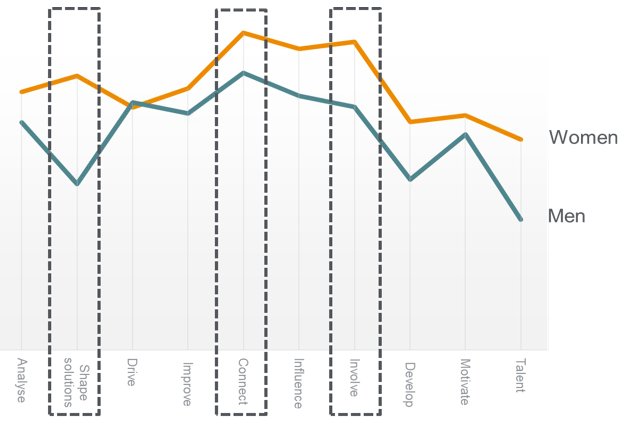By Tania Lennon, Global Space Lead, Talent Assessment and Leadership, ZS Associates, and Namita Powers, Principal, Customer Engagement Excellence, ZS
ZS has conducted extensive research into strategic account management success profiles. Using in-depth profiling, behavioral observations and manager reviews, ZS has identified critical competencies, skills and characteristics that drive high-performance outcomes in SAM roles, such as a shift in focus from achieving goals to achieving success and a more sophisticated approach that ZS identified in women account managers.
Men and women: Different paths to success
While there were some clear themes in the drivers of success for SAM roles, there were also some gender differences in how they achieved success. The graph highlights the key areas of difference between successful men and women SAMs.

Women SAMs demonstrated more sophisticated skills in three key areas important for success.
Shaping solutions. Women SAMs were more prepared to adapt value propositions to align with customer needs. In some cases this involved adapting the way that the product or proposition was described so that it aligned with and reflected the espoused issues and concerns of customers (influence). In other cases, SAMs adapted the proposition itself, whether by combining existing products and services in new ways or even co-creating new ideas with the customer. Women SAMs did this more often than men.
Connecting with customers. Women SAMs demonstrated higher levels of customer insight than men. At a personal level they were more effective at tuning into the needs, drivers and aspirations of their customers. At a business level, they picked up on customers’ levers of success in supporting them to achieve their goals. This aligns with other research (e.g., Woolley et al., 2010) showing that women have higher levels of social sensitivity than men. This supports them in more readily grasping the underlying challenges and needs of their customers, both at a personal and business level.
Involving Colleagues. Both men and women readily shared information with their colleagues about customers and accounts. In addition, both sought input from peers from different functions, knitting these together to reinforce the value proposition to customers. However, women tended to put more focus on creating and aligning cross-functional teams. They set out a clear vision for success and helped each team member feel engaged in delivering this vision. As a consequence, they were more likely to elicit unsolicited ideas and suggestions from colleagues to help them be successful with colleagues. The ZS research found a similar theme with women front-line managers, where they showed a greater propensity to set out a vision and align team members around common goals.
Are these capabilities making a difference?
The comparative achievements of men and women in account management are difficult to track due the complexity and long-term nature of these roles. However, data from the broader sales arena would suggest that the more sophisticated capabilities that ZS identified in women account managers are making a difference in results.
According to Xactly Insights, women-led sales teams achieve higher quota attainment. An Xactly Insights study of sales performance data showed that women achieve 8 percent higher quota attainment and earn a slightly higher commission rate but earn a lower base salary (86 percent of women and 78 percent of men achieved quota (2019). Xactly data also shows that women-led sales teams are more gender-balanced (45 percent women vs. 24 percent women on male-led teams); they recruit and retain more women to work with them. ZS found that in the high performing populations of the organizations in their study, 55 percent were female versus 45 percent male.
The implications for SAM talent The ZS research underlines the vital capabilities and talent that women bring to the account manager role. These capabilities align with the direction of the market as it becomes more connected, complex and competitive.
Why might women sales professionals be achieving better results? From ZS’ perspective, there are three main reasons:
- Buyer needs are changing. Enabled by the internet, buyers are more informed and self-sufficient. Buyers want to work with salespeople who understand their business needs, who can provide tailored solutions and insights, and who create business value. As the ZS data shows, women are better attuned to understanding these needs than men.
- Customer engagement has become a team sport. To meet changing buyer needs, different roles must work together to create the best outcomes. Skills in engaging and facilitating teams to meet these needs successfully therefore have a stronger influence on the outcomes achieved.
- Customers are becoming more gender-balanced. Organizations with a more diverse workforce provide superior service because they better understand customer needs (Wentling and Palmas-Rivas, 2000), are better at tapping into niche markets (Mueller, 1998) and diversified market segments (Fleury, 1999). Women also tend to stay longer in role (CEB Global), enabling the continuity of relationships that many customers value, in addition to their higher level of concern with enabling the success of their customers.
For much more on ZS’s research, be sure to check out the May issue of Velocity magazine, SAMA’s quarterly membership magazine.
- SAMA’s Annual Conference: The Ultimate ROI - February 12, 2024
- What’s In A Name? Turns Out — Everything! - February 1, 2024
- Procurement & Sales: A Complex Relationship - January 17, 2024

